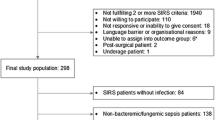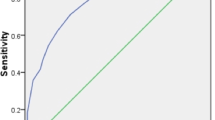Abstract
All cases of bacteremia caused solely byEscherichia coli in 1977–1979, 1987–1989, and 1993–1994 in a Finnish university hospital were reviewed retrospectively to determine the clinical manifestations, the outcome, and the prognostic factors. In 332 episodes, mortality during the month after the first positive blood culture was 17%. This figure diminished during the study period from 23% in the 1970s to 9% in the 1990s (p=0.028). Mortality was lowest among patients treated with a combination of antibiotics, 7% versus 18% among those treated otherwise (p=0.034). The use of acetaminophen increased during the study period from 18 to 55%. Mortality among patients who received acetaminophen within a period < 24 h to 48 h of the first positive blood culture was 10% versus 22% among others (p=0.002). Logistic regression analysis showed six factors predictive of a fatal outcome: pneumonia, no known focus, shock, CNS disorder, thromboembolism, and rapidly fatal underlying disease. Appropriate antibiotic therapy predicted survival. In the analysis, replacement of appropriate antibiotic therapy by acetaminophen revealed that this drug was significantly associated with survival.
Similar content being viewed by others
References
Finland M: Changing ecology of bacterial infections as related to antibacterial therapy. Journal of Infectious Diseases 1970, 122: 419–431.
Scheckler WE: Septicemia in a community hospital 1970 through 1973. JAMA 1977, 237: 1938–1941.
Roberts FJ: A review of positive blood cultures: identification and source of microorganisms and patterns of sensitivity to antibiotics. Reviews of Infectious Diseases 1980, 2: 329–339.
Young SEJ: Bacteraemia 1975–1980: a survey of cases reported to the PHLS Communicable Disease Surveillance Centre. Journal of Infection 1982, 5: 19–26.
Weinstein MP, Relter LB, Murphy JR, Lichtenstein KA: The clinical significance of positive blood cultures: a comprehensive analysis of 500 episodes of bacteremia and fungemia in adults. I. Laboratory and epidemiologic observations. Reviews of Infectious Diseases 1983, 5: 35–53.
Ispahani P: An analysis of community and hospital-acquired bacteraemia in a large teaching hospital in the United Kingdom. Quarterly Journal of Medicine 1987, New Series 63: 427–440.
Eykyn SJ, Gransden R, Phillips I: The causative organisms of septicemia and their epidemiology. Journal of Antimicrobial Chemotherapy 1990, 25, Supplement C: 41–58.
Roberts FJ, Geere IW, Coldman A: A three-year study of positive blood cultures, with emphasis on prognosis. Reviews of Infectious Diseases 1991, 13: 34–46.
Geerdes HF, Ziegler D, Lode H, Hund M, Loehr A, Fangmann W, Wagner J: Septicemia in 980 patients at a university hospital in Berlin: prospective studies during selected years between 1979 and 1989. Clinical Infectious Diseases 1992, 15: 991–1002.
Haug JB, Harthug S, Kalager T, Digranes A, Solberg CO: Bloodstream infections at a Norwegian university hospital, 1974–1979 and 1988–1989: changing etiology, clinical features, and outcome. Clinical Infectious Diseases 1993, 19: 246–256.
Banerjee NE, Emori TG, Culver DH, Gayness RP, Jarvis WR, Horan T, Edwards JR, Tolson J, Henderson T, Martone WJ: Secular trends in nosocomial primary bloodstream infections in the United States, 1980–1989. National Nosocomial Infections Surveillance System. American Journal of Medicine 1991, 91, Supplement 3B: 86–89.
McCabe WR, Jackson GG: Gram-negative bacteraemia. Archives of Internal Medicine 1962, 110: 847–864.
McGowan JE, Barnes MW, Finland M: Bacteremia at Boston City Hospital: occurrence and mortality during 12 selected years (1935–1972), with special reference to hospital acquired cases. Journal of Infectious Diseases 1975, 132: 316–335.
Gransden WR, Eykyn SJ: Bacteremia due toEscherichia coli: a study of 861 episodes. Reviews of Infectious Diseases 1990, 12: 1008–1018.
Weischer M, Kolmos HJ: Retrospective 6-year study of enterobacter bacteraemia in a Danish university hospital. Journal of Hospital Infection 1992, 20: 15–24.
Uzun Ö, Akalin HE, Hayran M, Ünal S: Factors influencing prognosis in bacteremia due to gram-negative organisms: evaluation of 448 episodes in a Turkish university hospital. Clinical Infectious Diseases 1992, 15: 866–873.
Altemeier WA, Todd JC, Inge WW: Gram-negative septicemia: a growing threat. Annals of Surgery 1967, 166: 530–542.
Kreger BE, Craven DO, Carling PC, McCabe WR: Gram-negative bacteremia. III. Reassessment of etiology, epidemiology and ecology in 612 patients. American Journal of Medicine 1980, 68: 332–343.
McCue JD: Improved mortality in gram-negative bacillary bacteremia. Archives of Internal Medicine 1984, 145: 1212–1216.
Bryant RE, Hood AF, Hood CE, Koenig MG: Factors affecting mortality of gram-negative rod bacteremia. Archives of Internal Medicine 1971, 127: 120–128.
McHenry MC, Gavan TL, Hawk WA, Ma C: Gram-negative bacteremia: variable clinical course and useful prognostic factors. Cleveland Clinic Quarterly 1975, 42: 15–32.
Weinstein MP, Murphy JR, Reller LB, Lichtenstein KA: The clinical significance of positive blood cultures: a comprehensive analysis of 500 episodes of bacteremia and fungemia in adults. II. Clinical observations, with special reference to factors influencing prognosis. Reviews of Infectious Diseases 1983, 5: 54–70.
Bryan CS, Reynolds KL, Brenner ER: Analysis of 1, 186 episodes of gram-negative bacteremia in non-university hospitals: the effects of antimicrobial therapy. Reviews of Infectious Diseases 1983, 5: 629–638.
National Committee for Clinical Laboratory Standards: Performance standards for antimicrobial susceptibility testing. Approved Standard M100-S5NCCLS, Villanova, PA, 1994.
Hosmer DW Jr, Lemeshow S: Applied logistic regression. Wiley-Interscience, New York, 1989.
Dixon WJ (ed): BMDP statistical software manual. University of California Press, Los Angeles, 1992.
Kuikka A, Valtonen VV: Improved outcome ofStaphylococcus aureus bacteremia. Infectious Diseases in Clinical Practice 1994, 3: 282–287.
Young LS: Sepsis syndrome. In: Mandell GL, Bennett JE, Dolin R (ed): Principles and practice of infectious diseases. Churchill Livingstone, New York, 1995, p. 690–705.
Okusawa S, Gelfand JA, Ikejima T, Connolly RJ, Dinarello CA: Interleukin 1 induces shock-like stage in rabbits. Synergism with tumor necrosis factor and the effects of cyclooxygenase inhibition. Journal of Clinical Investigation 1988, 81: 1162–1172.
Carey PD, Jenkins JK, Byrne K, Walsh CJ, Fowler AA, Sugerman HJ: The neutrophil respiratory burst and tissue injury in septic acute lung injury: the effect of cyclooxygenase inhibition in swine. Surgery 1992, 112: 45–55.
Abramson S, Korchak H, Ludewig R, Edelson H, Haines K, Levin RI, Herman R, Rider L, Kimmel S, Weissman G: Modes of action of aspirin-like drugs. Proceedings of the National Academy of Sciences of the USA 1985, 82: 7227–7231.
Seppälä E, Nissilä M, Isomäki H, Wuorela H, Vapaatalo H: Effects of non-steroidal anti-inflammatory drugs and prednisolone on synovial fluid white cells, prostaglandin E2, leukotriene B4 and cyclic AMP in patients with rheumatoid arthritis. Scandinavian Journal of Rheumatology 1990, 19: 71–75.
Weissmann G: Prostaglandins as modulators rather than mediators of inflammation. Journal of Lipid Mediators 1993, 6: 275–286.
Mollner S, Beck K, Pfeuffer T: Acylation of adenyl cyclase catalyst is important for enzymic activity. FEBS Letters 1995, 371: 241–244.
Lozada ES, Gouaux J, Franki N, Appel GB, Hays RM: Studies of the mode of action of the sulfonylureas and phenylacetamides in enhancing the effect of vasopressin. Journal of Clinical Endocrinology 1972, 34: 704–712.
Shalabi EA: Acetaminophen inhibits the human polymorphonuclear leukocyte function in vitro. Immunopharmacology 1992, 24: 37–45.
Author information
Authors and Affiliations
Rights and permissions
About this article
Cite this article
Kuikka, A., Sivonen, A., Emelianova, A. et al. Prognostic factors associated with improved outcome ofEscherichia coli bacteremia in a Finnish university hospital. Eur. J. Clin. Microbiol. Infect. Dis. 16, 125–134 (1997). https://doi.org/10.1007/BF01709471
Issue Date:
DOI: https://doi.org/10.1007/BF01709471




